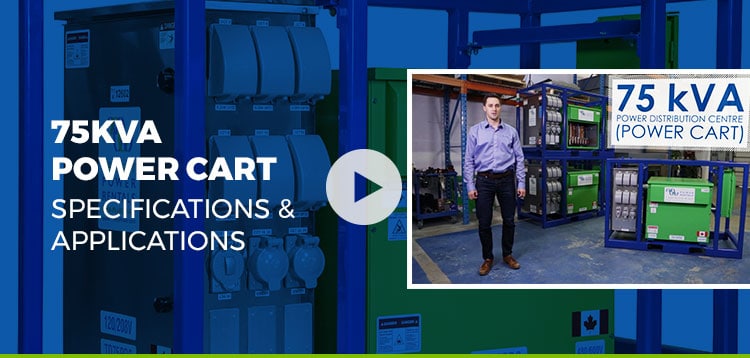- OUR APPROACH
-
COMMITTED TO YOUR SUCCESS
Our approach, developed over decades of experience, is fine-tuned to get the results you want.
We deliver concept-to-completion solutions, designed by temporary power specialists with access to the largest inventory of high-quality power generation and distribution equipment in North America.
-
- Equipment
-
RENTALS
From a wide range of diesel and natural gas generators to transformers, cable, light towers and more, our large rental fleet and extensive vendor network ensure we’ll have the temporary power equipment that your project requires — every time.

-
- Industries
-
INDUSTRIES WE SERVE
For nearly 20 years, we have been at work powering projects across Canada’s industrial sectors.
Select from this sampling of industries to learn how we can put our expertise to work for you.
VIEW ALL- Projects
- About
-
A PROUD HISTORY. A BRIGHT FUTURE.
From our inception in 1998, we have been building our team on a foundation of excellence. Our team members’ passion, expertise and commitment are what have allowed us to grow into a national company with projects across Canada.
Click on the links to learn more about our history, our team or our career opportunities.
- Blog
- Contact
-
On February 11, the first of two winter storms hit Texas, causing temperatures to dip as low as -2 degrees Fahrenheit, and triggering one of the worst energy crises the state has experienced.
As people tried to heat their homes and businesses, demand for power surged while supply froze, quite literally. Facing the very real possibility of a major grid failure, ERCOT, Texas’ centralized utility company, initiated a series of rolling blackouts across the state.
This left millions without heat in the face of some of the coldest temperatures recorded in Texas in over 70 years.
The Trinity Power branch in Houston has been working night and day to help mitigate the effects of this disaster. Working together with our partners, we have provided the distribution equipment needed to bring a children’s hospital back online, to restore heat to a seniors’ home, to ensure inmates at a county jail would have power and heat, to ensure a number of COVID-19 related facilities would be able to continue operating.
Last week, we spoke with Chris Zelman, our Fleet Manager in Houston, who explained the technical aspects of widespread emergency outages like the one in Texas, and offered a first-hand perspective on the situation.
“We weren’t even thinking about it.”: Why Cold Weather in Texas Took Such a Big Toll
“Typical power outages in Texas are usually related to tropical storms, hurricanes, tornadoes and the like,” explains Zelman. “This has definitely been a unique experience.”
That’s saying a lot, considering Zelman has lived through major hurricanes, including Hurricane Harvey.
While hurricanes are a relatively frequent occurrence along the gulf coast, extreme cold wasn’t something that anyone was expecting. In fact, very low temperatures are so uncommon that, Zelman explains, power generation plants are built out in the open rather than inside of protective enclosures the way they are in areas with cooler climates.
“I joke and say we get 8 hours of winter every year,” Zelman laughs. “We look at the guys in Alberta and it’s -30, so we can’t even talk about being cold – not compared to those guys. But their equipment and resources are designed around those cold temps and ours are not.”
This lack of protection from the elements was part of the reason that so many sources of power were taken out at the same time. Coal, solar, wind and nuclear power were all affected by the sudden extreme cold. But possibly the biggest blow was the freezing of natural gas pipelines.
“We just don’t see so many diverse power sources hit at the same time like they were,” explains Zelman. “Hands down this is an incredibly rare situation.”
Utilities Do Prepare for Disasters: Just Not This One
The unexpected nature of the winter storms and concurrent cold temperatures is one of the primary reasons that the power grid in Texas was caught so off guard. Typically, utilities will prepare in advance for inclement weather and natural disasters.
“On the West Coast during fire season, and down here on the Gulf Coast when it’s hurricane season, a lot of times, the utilities will work with generator rental companies to have both generation and distribution equipment prepared ahead of time so that they can put power onto the grid during peak times.” explains Zelman. “So normally, there are opportunities to mitigate some of this.”
Rolling Blackouts: When the Solution is Also the Problem
As temperatures dropped, power generation facilities went offline and Texans began to turn up the heat in their homes and businesses. That’s when ERCOT began to trigger rolling blackouts.
Why would a power utility company do something like this? “Rolling blackouts are one of their safety nets,” explains Zelman, “so it’s a typical practice. The problem is, we’re typically dealing with heat rather than the cold. People aren’t accustomed to this.”
Rolling blackouts are scheduled as a way to avoid a catastrophic failure. “It’s just like in your home when you have too much load on one particular circuit,” Zelman explains. “That trips a breaker and you have a failure. The demand on the grid is too high for the supply, so they’ve got to manage the demand by force of hand.”
Typically, this type of blackout will last for a matter of hours. But this time, millions of people ended up without power for days, during a time when temperatures were cold enough to pose a serious risk.
The blackouts were the result of a choice between two bad options — controlled outages or the risk of uncontrolled grid failure — and the decision that was made left many families and businesses to fend for themselves.
Preparing for Disaster is the Best Way to Overcome It
Can businesses really prepare for an event that is so completely unexpected? “They actually can,” says Zelman. “We do this during hurricane season. We make contingency plans, where customers will actually put equipment on rent preemptively.” Trinity then stores that equipment in the yard until the hurricane reaches a certain distance from shore. “They may never need it, but that customer has that equipment on rent from day one, so that they can deploy it quickly if it is needed.”
What about facilities that already have a permanent backup power supply? In Texas, reports of COVID-19 vaccine storage facilities losing both grid power and backup power beg the question: how can facilities that rely on maintaining a critical load trust that their backup power will work when they need it to?
“The biggest key to having consistent power is going to be redundancy,” explains Zelman. “A company might reach out to us when they know a storm is coming. They will bring in a temporary generator to park beside their permanent generator and we can install distribution equipment so that the temporary generator can kick in if needed.”
Beyond redundancy, regular testing and maintenance will help to ensure that the backup power system is operating as it should.
Zelman stresses that while having backup power is important, that isn’t all there is to creating an effective contingency plan. “You have people stuck at companies with no power, he says, “but the company also has no water, no food prepared, no essentials.” And the current situation in Texas bears this out, where millions of people are now without access to clean, running water due to burst pipes.
“We all have these strategies and fire escape plans, but people don’t always have plans for natural disasters like cold temps or hurricanes or wildfires,” says Zelman. “So taking the time to make sure you’ve got a day or two worth of supplies prepared in a closet somewhere – to me, that’s huge.”
A Long Road Ahead: What’s Next for Texas?
The winter storms have passed, and the majority of Texans have their power back, but the recovery efforts — and the conversations about what has happened, and what, if anything, could have been done differently — will continue for a long time to come.
”I don’t think most people fully understand what it really takes to turn your lights on,” says Zelmer, who sees knowledge sharing as a contribution that both he and the rest of the Trinity Power Rentals team make in their community. “It’s something we talk about at Trinity regularly, mainly because this is what our business is. It’s what we’re used to.”
“Something that Trinity has built a culture around is helping people and sometimes that’s just simply sharing knowledge.”
Related Articles
Subscribe for access to exclusive content


















